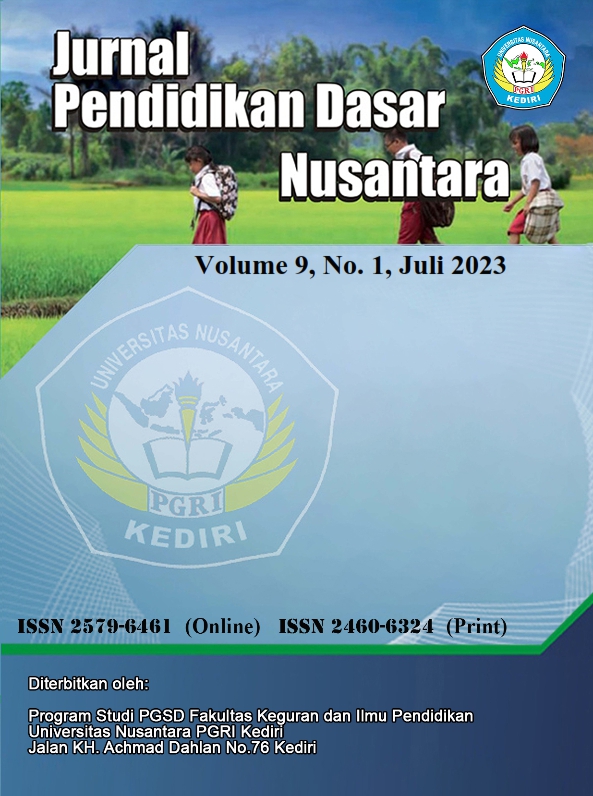Implementation of problem-based learning (PBL) model assisted by PAJURA media to improve learning outcomes of second-grade elementary school students
DOI:
https://doi.org/10.29407/jpdn.v9i1.20148Keywords:
Problem-Based Learning, Learning Media, Learning OutcomesAbstract
The purpose of this research was to determine the improvement of students' learning outcomes by implementing the Problem-Based Learning (PBL) model assisted by PAJURA media in understanding the concepts of addition and subtraction operations on whole numbers. This study is classified as Classroom Action Research (CAR) comprising two cycles. The subjects are 27 second-grade students of SDN Mojorejo 1 Batu in the academic year 2022/2023. The data collection method in this research is through tests to gather students' learning outcomes data. The results of this study indicate that the implementation of the Problem-Based Learning (PBL) model assisted by PAJURA media can improve students' learning outcomes in understanding the concepts of addition and subtraction operations on whole numbers in grade 2. This improvement is evident in the student's learning outcomes. The initial data (pre-cycle) showed an average learning outcome of 67% with a mastery learning rate of 41%. After the implementation of the Problem-Based Learning (PBL) model assisted by PAJURA media in the first cycle, the average learning outcome increased to 79% with a mastery learning rate of 70%. Following the improvement in the second cycle, there was a further enhancement in the average learning outcome percentage, reaching 88%, with a mastery learning rate of 89%.
Downloads
References
Arnidha, Y., Noerhasmalina, & Rekawati, D. (2018). Model Problem Based Learning (Pbl) Pada Pembelajaran Matematika. JURNAL E-DuMath, 4(2), 46–51. https://doi.org/10.26638/je.755.2064
Astuti, D. F., Syam, N., & Hairuddin. (2022). Penerapan Model Problem Based Learning Menggunakan Media Stick Eskrim Untuk Meningkatkan Hasil Belajar Siswa Kelas 1 SD Negeri Selopukang. Pinisi Journal PGSD, 2(2), 559–563.
Dahlia. (2022). Penerapan Model Pembelajaran Problem Based Learning untuk Meningkatkan Hasil Berlajar Matematika Topik Bilangan Cacah. Pedagogia: Jurnal Ilmiah Pendidikan, 14(2), 59–64. https://doi.org/10.55215/pedagogia.v14i2.6611
Darmayoga, I. W. (2023). Penerapan MetodePembelajaranExperiental Learning Berbantu Media Audiovisual Untuk Meningkatkan Hasil Belajar Siswa. Edukasi: Jurnal Pendidikan Dasar, 4(1), 1–10.
Eismawati, E., Koeswanti, H. D., & Radia, E. H. (2019). Peningkatan Hasil Belajar Matematika Melalui Model Pembelajaran Problem Based Learning (PBL) Siswa Kelas 4 SD. Jurnal Mercumatika: Jurnal Penelitian Matematika Dan Pendidikan Matematika, 3(2), 71–78. https://doi.org/10.31764/justek.v1i1.416
Fariatun, M., Achmad, W. K. S., & Mus, I. (2022). Penerapan Model Problem Based Learning Untuk Meningkatkan Hasil Belajar Muatan Pelajaran Matematika. Pinisi Journal PGSD, 2(2), 696–706. https://doi.org/10.56916/ejip.v1i1.7
Firdaus, A., Asikin, M., Waluya, B., & Zaenuri, Z. (2021). Problem Based Learning (PBL) Untuk Meningkatkan Kemampuan Matematika Siswa. QALAMUNA: Jurnal Pendidikan, Sosial, Dan Agama, 13(2), 187–200. https://doi.org/10.37680/qalamuna.v13i2.871
Handayani, E. (2017). Penerapan Model Problem Based Learning untuk Meningkatkan Kemampuan Memahami Perkalian Bilangan. Briliant: Jurnal Riset Dan Konseptual, 2(3), 319–327. https://doi.org/10.28926/briliant.v2i3.75
Nugraha, T. S. (2022). Kurikulum Merdeka untuk Pemulihan Krisis Pembelajaran. Jurnal UPI, 19(2), 251–262.
Nurmala. (2021). Penerapan Model Pembelajaran Problem Based Learning (PBL) untuk Meningkatkan Hasil Belajar Siswa Pada Mata Pelajaran Matematika Kelas III SDN Mangkura 4 Kota Makassar. In Eprints.Uad.Ac.Id. http://eprints.uad.ac.id/5284/1/Deany R. Rosalina 130005049 Perpus PGSD Kls A.docx
Octaviana, A., Nuryani, P., & Robandi, B. (2018). Penerapan Model Problem Based Learning (PBL) untuk Meningkatkan Hasil Belajar Matematika siswa Kelas III Sekolah Dasar. Jurnal Pendidikan Guru Sekolah Dasar, 3(3), 12–20.
Puspitasari, I. A., Azainil, & Basir, A. (2022). Penggunaan Media Pembelajaran Dalam Model Pembelajaran Problem Based Learning Pada Mata Pelajaran Matematika. Prosiding Seminar Nasional Pendidikan Matematika, Universitas Mulawarman, 2, 75–92.
Taspiah, S., & Hasan, K. (2021). Penerapan Model Pembelajaran Problem Based Learning Meningkatkan Hasil Belajar Matematika Siswa SD. Pinisi Journal PGSD, 1(2), 643–649. https://doi.org/10.23887/jippg.v4i2.35695
Widyastuti, E., Sahabuddin, E. S., & Latif, R. A. (2022). Upaya Meningkatkan Hasil Belajar Matematika Melalui Model Pembelajaran Problem Based Learning (PBL) Pada Siswa Kelas II SD. Pinisi Journal Pendidikan Guru, 2(1), 115–122.
Winarti, T., & Noor Fatirul, A. (2020). Model Pembelajaran Problem Based Learning, Inkuiri Terbimbing, dan Learing Creativity Berpengaruh Terhadap Prestasi Belajar Matematika. Jp2, 3(3), 387–396.
Yanti, A. H. (2017). Penerapan Model Problem Based Learning (PBL) Terhadap Kemampuan Komunikasi dan Kemampuan Pemecahan Masalah Matematika Siswa Sekolah Menengah Pertama Lubuklinggau. Jurnal Pendidikan Matematika Raflesia, 2(2), 118–129.
Downloads
Published
How to Cite
Issue
Section
License
Authors who publish with this journal agree to the following terms:
1. Copyright on any article is retained by the author (s)
2. The author grants the journal, right of first publication with the work simultaneously licensed under a Creative Commons Attribution License that allows others to share the work with an acknowledgment of the work’s authorship and initial publication in this journal.
3. Authors are able to enter into separate, additional contractual arrangements for the non-exclusive distribution of the journal’s published version of the work (e.g., post it to an institutional repository or publish it in a book), with an acknowledgment of its initial publication in this journal.
4. Authors are permitted and encouraged to post their work online (e.g., in institutional repositories or on their website) prior to and during the submission process, as it can lead to productive exchanges, as well as earlier and greater citation of published work.
5. The article and any associated published material is distributed under the Creative Commons Attribution-ShareAlike 4.0 International License
































